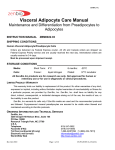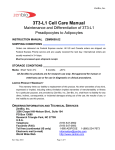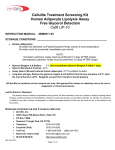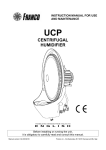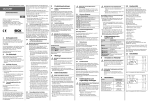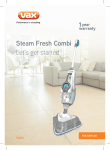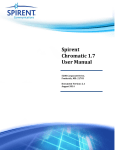Download ZBM0001.01SQAdipocyt... - Zen
Transcript
ZenBio, Inc. Subcutaneous Human Adipocytes Maintenance and Differentiation from Preadipocytes to Adipocytes INSTRUCTION MANUAL ZBM0001.03 SHIPPING CONDITIONS Human Adipocyte/Preadipocyte Cells Orders are delivered via Federal Express courier. All US and Canada orders are shipped via Federal Express Priority service and are usually received the next day. International orders are usually received in 3-4 days. Must be processed upon shipment receipt. STORAGE CONDITIONS Media: Short Term 4°C 6 months -20°C All Zen-Bio Inc products are for research use only. Not approved for human or veterinary use or for use in diagnostic or clinical procedures. LIMITED PRODUCT WARRANTY This warranty limits our liability to replacement of this product. No other warranties of any kind, expressed or implied, including without limitation implied warranties of merchantability or fitness for a particular purpose, are provided by Zen-Bio, Inc. Zen-Bio, Inc. shall have no liability for any direct, indirect, consequential, or incidental damages arising out of the use, the results of use, or the inability to use this product. Zen-Bio, Inc warrants its cells only if Zen-Bio media are used and the recommended protocols are followed. Cryopreserved preadipocytes are assured to be viable when thawed and maintained according to Zen-Bio protocols. ORDERING INFORMATION AND TECHNICAL SERVICES ZenBio, Inc. 3200 Chapel Hill-Nelson Blvd., Suite 104 PO Box 13888 Research Triangle Park, NC 27709 U.S.A. Telephone (919) 547-0692 Facsimile (FAX) (919) 547-0693 Toll free (continental US only) 1-866-ADIPOSE 1-(866)-234-7673 Electronic mail (e-mail) [email protected] World Wide Web http://www.zenbio.com Rev Oct 2010 Page 1 of 14 US PATENT (6,153,432) ZenBio, Inc. CONTENTS PAGE # Introduction 3 Materials Provided for Each Catalog Item 3 Media Compositions 4 Maintenance of Preadipocytes 5 Maintenance of Adipocytes 6 Differentiation of Preadipocytes into Adipocytes 7 Plating Procedure for Cryopreserved Subcutaneous Preadipocytes 9 Expansion Procedure for Cryopreserved Subcutaneous Preadipocytes 10 Troubleshooting 11 Frequently Asked Questions 12 Pathogen Testing 14 Rev Oct 2010 Page 2 of 14 US PATENT (6,153,432) ZenBio, Inc. INTRODUCTION Cultured human adipocytes The adipocyte precursor cells (preadipocytes) are isolated from subcutaneous adipose tissue of healthy non-diabetic donors between 18 and 60 years old undergoing elective surgery. The preadipocytes are isolated by centrifugal force after collagenase treatment. Preadipocytes can be cultured as growing precursor cells or differentiated into adipocytes using medium supplemented with adipogenic and lipogenic hormones. This instruction manual describes procedures to induce human preadipocytes to differentiate into mature adipocytes as well as culturing methods for human preadipocytes and adipocytes. The process of differentiating preadipocytes to adipocytes has been patent protected by Zen-Bio under US patent number 6153432. PRECAUTIONS This product is for research use only. It is not intended for human, veterinary, or in vitro diagnostic use. Proper precautions and biological containment should be taken when handling cells of human origin, due to their potential biohazardous nature. Always wear gloves and work behind a protective screen when handling primary human cells. All media, supplements, and tissue cultureware used in this protocol should be sterile. Human preadipocyte viability depends greatly on the use of suitable media, reagents, and sterile plastic wear. If these parameters are not carefully observed, limited differentiation may occur and cell growth may be slow. MATERIALS PROVIDED FOR EACH CATALOG ITEM Note: Zen-Bio recommends that the Human Preadipocytes and Adipocytes be processed immediately upon receipt. Human Subcutaneous Preadipocytes (Cat# SP-2096; SP-2048; SP-2024; SP-2012; SA-2006; SP-75; SP-25) Approximately 100 %confluent Human Subcutaneous Adipocytes (Cat# SA-1096; SA-1048; SA-1024; SA-1012; SA-1006; SA-75; SA-25) Cryopreserved subcutaneous preadipocytes (catalog # SP-F) Frozen vial containing at least 2 x106 preadipocytes (store in liquid nitrogen upon receipt) 50 ml Preadipocyte medium Rev Oct 2010 Page 3 of 14 US PATENT (6,153,432) ZenBio, Inc. MEDIA COMPOSTIONS Preadipocyte Medium cat # PM-1 DMEM / Ham’s F-12 (1:1, v/v) HEPES pH 7.4 Fetal bovine serum Penicillin Streptomycin Amphotericin B Adipocyte Differentiation Medium cat # DM-2 DMEM / Ham’s F-12 (1:1, v/v) HEPES pH 7.4 Fetal bovine serum Biotin Pantothenate Human insulin Dexamethasone Isobutylmethylxanthine PPAR agonist Penicillin Streptomycin Amphotericin B Adipocyte Maintenance Medium cat # AM-1 DMEM / Ham’s F-12 (1:1, v/v) HEPES pH 7.4 Fetal bovine serum Biotin Pantothenate Human insulin Dexamethasone Penicillin Streptomycin Amphotericin B Adipocyte Basal Medium Cat# BM-1 DMEM / Ham’s F-12 (1:1, v/v) HEPES pH 7.4 Biotin Pantothenate All media contain 3.15g/L (17.5 mmol/L) D-glucose. All media are also available as without serum and/or phenol red free. Please inquire for custom media requests. MEDIA EXPIRATION DATES: If placed at 4C upon arrival, the media is stable until the expiration date on the bottle label. If stored at -20C upon arrival, the media is stable for 6 months. Add fresh antibiotics when you are ready to use. The media will expire 30 days after the thaw date. Rev Oct 2010 Page 4 of 14 US PATENT (6,153,432) ZenBio, Inc. MAINTENANCE OF PREADIPOCYTES Your preadipocytes have arrived in our patented CellPorter packaging system. Upon receiving the plates, please follow the instructions carefully to ensure your safety and the optimal performance of these cells. 1) Check the seal for each plate. Discard any plate where the vacuum seal has been compromised during shipment. Please be aware that these cells are of human origin. Please treat them as potentially infectious since we cannot test for all pathogens. ALWAYS WEAR GLOVES AND USE PROTECTIVE MEASURES WHEN HANDLING HUMAN PRIMARY CELLS. 2) Place the package into a sterile environment. THIS IS VERY IMPORTANT SINCE BREAKING THE VACUUM SEAL MAY POTENTIALLY INTRODUCE CONTAMINATION INTO THE PLATE. Use scissors to snip open the bag at any end. The vacuum seal should be released at this time. You may notice some bubbling of the medium in the plate at this time. This is normal and will not affect cell performance. 3) In a sterile environment, remove the plate from the bag, taking care to not disturb the cover top from the plate. Open the lid and remove the white liner using sterile forceps or a hemostat and discard. Carefully remove the clear adhesive seal by grabbing the edge with sterile forceps or hemostat and lifting the film slowly towards the other end. Discard adhesive film in appropriate biohazard waste container. Replace lid on plate. 4) The excess medium added to each well for shipping should be removed before incubation in a humidified atmosphere CO2 incubator. Depending upon the plate configuration, please use the chart below to determine medium volumes to remove from each well. Cultureware 96 well plates 48 well plates 24 well plates 12 well plates 6 well plates 75cm2 flask 25cm2 flask Total shipping volume per well Removal volume per well 300 l/well 1.3 ml/well 3.0 ml/well 5.8 ml/well 8.8 ml/well 260ml/flask 72 ml/flask 150 l 0.8 ml 2.0 ml 3.8 ml 5.8 ml 240 ml 65 ml 5) Keep the plates at 37oC with 5% CO2 in a humidified incubator until ready for use. Differentiation into adipocytes should be initiated immediately (see page 7). If cells are to be maintained as preadipocytes, they should be fed with Preadipocyte Medium (PM-1) every other day. Preadipocytes are flat, phase-dark spindle-shaped cells. The cells have a similar appearance in culture to fibroblasts or smooth muscle cells (see Figure 1-A). The majority of the preadipocytes will differentiate into adipocytes (see Figure 1-C) using Adipocyte Differentiation Medium (cat# DM-2) and Adipocyte Maintenance Medium (cat# AM-1) as described in this manual. The differentiation efficiency varies depending on the donor. The patient information provided on the product sheet is limited to sex, age, and BMI of the donor. Please see the Certificate of Analysis that came with your order for information specific to the cells you are using. Rev Oct 2010 Page 5 of 14 US PATENT (6,153,432) ZenBio, Inc. MAINTENANCE OF ADIPOCYTES Your adipocytes have arrived in our patented CellPorter packaging system. Upon receiving the plates, please follow the instructions carefully to ensure your safety and the optimal performance of these cells. 1) Check the seal for each plate. Call Zen-Bio if there is any problem with the shipment. Please be aware that these cells are of human origin. Please treat them as potentially infectious since we cannot test for all pathogens. ALWAYS WEAR GLOVES AND USE PROTECTIVE MEASURES WHEN HANDLING HUMAN PRIMARY CELLS. 2) Place the package into a sterile environment. THIS IS VERY IMPORTANT SINCE BREAKING THE VACUUM SEAL MAY POTENTIALLY INTRODUCE CONTAMINATION INTO THE PLATE. Use scissors to snip open the bag at any end. The vacuum seal should be released at this time. You may notice some bubbling of the medium in the plate at this time. This is normal and will not affect cell performance. 3) In a sterile environment, remove the plate from the bag, taking care to not disturb the cover top from the plate. Open the lid and remove the white liner using sterile forceps or a hemostat and discard. Carefully remove the clear adhesive seal by grabbing the edge with sterile forceps or hemostat and lifting the film slowly towards the other end. Discard adhesive film in appropriate biohazard waste container. Replace lid on plate. 4) The excess medium added to each well for shipping should be removed for incubation in a CO2 incubator. When changing medium, do not remove all the liquid as the cells will detach and float. Depending upon the plate configuration, please use the chart below to determine medium volumes to remove from each well. Cultureware Total shipping volume per well Removal volume per well 96 well plates 300 l/well 1.3 ml/well 3.0 ml/well 5.8 ml/well 8.8 ml/well 260ml/flask 72 ml/flask 150 l 0.8 ml 2.0 ml 3.8 ml 5.8 ml 240 ml 65 ml 48 well plates 24 well plates 12 well plates 6 well plates 75cm2 flask 25cm2 flask 5) Keep the plates at 37oC with 5% CO2 in a humidified incubator until ready for use. 6) When feeding, we recommend you remove and replace approximately half of the volume of each well. The adipocytes should remain healthy and responsive for at least four weeks after induction of differentiation. Unless otherwise stated on the plate, cultured adipocytes will be 2-3 weeks old upon receipt. Different lots will vary due to patient variation. We recommend doing one whole set of experiments using cells from the same lot number. When large numbers of plates are needed, please contact Zen-Bio to reserve a lot for any specific orders. Rev Oct 2010 Page 6 of 14 US PATENT (6,153,432) ZenBio, Inc. DIFFERENTIATION OF PREADIPOCYTES INTO ADIPOCYTES 1. Preadipocytes are plated confluent in Preadipocyte Medium (cat# PM-1) and shipped the same day via overnight delivery. Differentiation should be initiated within 24 hours after receiving the cells. Please contact Zen-Bio, Inc. to coordinate the shipping date with your schedule. 2. To start the process, aspirate the entire volume of Preadipocyte Medium from all wells. Add the appropriate volume of Adipocyte Differentiation Medium (catalog # DM-2) to the wells (see Table 1. Feeding Volumes). Incubate plate for 7 days at 370C and 5% CO2. 3. After 7 days, cells should be fed by removing some of the media and replacing with fresh Adipocyte Medium (catalog # AM-1) (See Table 1. Feeding Volumes). Caution: Do not dry the wells. Add new medium gently. If using an automatic feeder, set the slowest flow rate possible. 4. Two (2) weeks after the initiation of differentiation, cells should appear rounded with large lipid droplets apparent in the cytoplasm (see Figure 1-C). Cells are now considered mature adipocytes and are suitable for most assays. Table 1. Feeding Volumes Format Plating Change PM-1 to DM-2 Change DM-2 to AM-1 Change AM-1 to AM-1 IN OUT IN OUT IN OUT IN 96 well plate 150 l/ well 150 l/ well 150l/ well 90 l/ well 120 l/ well 90 l/ well 90 l/ well 48 well plate 500 l/ well 500l/ well 500l/ well 300l/ well 40 l/ well 300 l/ well 300 l/ well 24 well plate 1.0 ml/well 1.0 ml/well 1.0 ml/well 0.6 ml/well 0.8 ml/well 0.6 ml/well 0.6 ml/well 12 well plate 2.0 ml/well 2.0 ml/well 2.0 ml/well 1.2 ml/well 1.6 ml/well 1.2 ml/well 1.2 ml/well 6 well plate 3.0 ml/well 3.0 ml/well 3.0 ml/well 1.8 ml/well 2.4 ml/well 1.8 ml/well 1.8 ml/well T-75 flask 20 ml/flask 20 ml/flask 20 ml/flask 12 ml/flask 16 ml/flask 12 ml/flask 12 ml/flask T-25 flask 7 ml/flask 7 ml/flask 7 ml/flask 4.2ml/flask 5.6ml/flask 4.2 ml/flask 4.2 ml/flask Rev Oct 2010 Page 7 of 14 US PATENT (6,153,432) ZenBio, Inc. A. 100% Confluent preadipocytes B. 1-week-old adipocytes (1 wk post-differentiation) C. 2-week-old adipocytes (2 wks post-differentiation) PREADIPOCYTE MATURE ADIPOCYTE nucleus Lipid droplets nucleus Figure 1: Photographs of 100% confluent Preadipocytes (A), 1-week-old (post-differentiation) cultured adipocytes (B) and mature (2 weeks post-differentiation) cultured Adipocytes (C). These are unstained photographs of human preadipocyte morphology (20X). The cells should appear comparable in appearance to these pictures. The preadipocytes should be confluent 24-48 hours after plating for differentiation. If they are not 100% confluent, the cells will not differentiate well. Please see the Troubleshooting guide for any problems. Rev Oct 2010 Page 8 of 14 US PATENT (6,153,432) ZenBio, Inc. PLATING PROCEDURE Cryopreserved Subcutaneous Preadipocytes (Catalog # SP-F) Please note: Primary cells can be very sensitive to brands of cultureware. Zen-Bio does not currently recommend the use of Falcon or Sarstedt brand plates or flasks. Our scientists are using Nunc, Costar/Corning, or Greiner bio-one Cellstar tissue culture treated plates and flasks. Please contact us if you have any questions. 1. Remove cells from liquid nitrogen and place immediately into a 37 C water bath and agitate while in bath. Be careful not to submerge the cap of the vial into water. Do not leave the vials in water bath after most of the content has thawed. Rinse the vials with 70% ethanol before taking them to the culture hood. 2. Upon thawing, transfer the cells to a sterile conical bottom centrifuge tube containing 10 ml of Preadipocyte Medium (cat # PM-1). Centrifuge: 1,200 rpm (282 X g) / 20C / 5 minutes. Aspirate the supernatant. TAKE CARE TO NOT ASPIRATE ANY OF THE CELL PELLET. 3. The cell vial contains a minimum of 2.0 x 106 viable cells; however, we recommend performing a cell count to determine a more exact number of cells. Resuspend the cell pellet in 2 ml Preadipocyte Medium, dilute an aliquot in 0.4% trypan blue solution. We suggest withdrawing an aliquot of 50 l of cells and mixing with 100 l of the trypan blue solution, resulting in a dilution factor of 3. Count live (unstained) cells on a hemacytometer. 4. Plate approximately 40,625 cells / cm2 using the media volumes from the table below. Refer to the manufacturer’s specifications for the specific cultureware brand you are using. FORMAT VOLUME PER WELL 96 well plate 150 l 48 well plate 500 l 1 ml 2 ml 3 ml 15 ml 20 ml 7 ml 24 well plate 12 well plate 6 well plate 10 cm dish T-75 flask T25 flask TOTAL VOLUME PER FORMAT* 14.4 ml 24.0 ml 24.0 ml 24.0 ml 18.0 ml 15.0 ml 20.0 ml 7.0 ml *We recommend preparing slightly larger volumes to allow for loss due to foam and pipet error. 5. Plate cells in desired format and place in a humidified 37oC incubator with 5% CO2. Do not agitate the plate, as cells will not plate evenly. 6. Twenty-four hours after plating, check the plates for confluence. If they are not completely confluent, leave for and additional 24 hours maximum before inducing differentiation. If the cells are not confluent after 48 hours, DO NOT INDUCE DIFFERENTIATION (differentiation will be poor). Contact Zen-Bio immediately. 7. To differentiate the cells please see the protocol on page 7 starting at step 2. Rev Oct 2010 Page 9 of 14 US PATENT (6,153,432) ZenBio, Inc. EXPANSION PROCEDURE Cryopreserved Subcutaneous Preadipocytes (Catalog # SP-F) 1. Remove cells from liquid nitrogen and place immediately into a 37C water bath with agitation. Be careful not to submerge the cap of the vial into water. Do not leave the vials in water bath after most of the content has thawed. Rinse the vials with 70% ethanol before taking them to the culture hood. 2. Upon the thawing, add the cells to a sterile conical bottom centrifuge tube, containing 10 ml of Preadipocyte Medium (PM-1). 3. Centrifuge at 280 x g, 20C, 5 minutes. Aspirate the medium and resuspend cells in a volume of PM-1 appropriate for counting the cells. Count using a hemacytometer. 5 4. Place approximately 6.7 X 10 cells in T-75 culture flasks using Preadipocyte Medium (PM-1). 5. Incubate cells until they are 85-90% confluent (in about 4-5 days). Do not let the cells become 100% confluent (see Figure 1-A for picture of 100% confluent cells). Cells will need to be fed every other day with PM-1. 6. Aspirate medium and wash preadipocytes 4-5 times using sterile Phosphate Buffered Saline (PBS) to remove all traces of serum (until there is no foaming of the medium). Remove the PBS and release the cells from the flask bottom by adding 2 mL/T-75 flask (or 6 ml/T-225 flask) of 0.25% trypsin/ 2.21mM EDTA solution. Allow cells to trypsinize for 5 minutes at 37C. Tap the flask gently to loosen the cells. 7. Neutralize the trypsin using 7 ml Preadipocyte Medium (cat# PM-1) per T-75 flask (or 21 ml per T-225 flask). Check the flask under a microscope to ensure all cells are free of the flask bottom. 8. Count the cells and plate in desired format (see page 9 for plating protocol). Ensure cells are evenly suspended when plating large numbers of plates or flasks. Do not agitate plates and flasks after plating. Place in a humidified incubator at 37C and 5% CO2, making sure the surface is level for even cell distribution. 9. Follow the differentiation protocol as outlined on page 7. 10. We DO NOT recommend differentiating preadipocytes that are older than Passage 4. Cells will arrive at Passage 2 or 3. Rev Oct 2010 Page 10 of 14 US PATENT (6,153,432) ZenBio, Inc. TROUBLESHOOTING GUIDE Observation Preadipocytes do not differentiate Possible causes 1. Cells have been passaged too many times 2. Differentiation conditions not optimal Preadipocytes do not attach well or do not grow Edge effects Adipocytes appear uneven in each well Rev Oct 2010 Suggestions 1. Use cells of a lower passage number 2. Use our defined differentiation media. Make sure that wells are confluent BEFORE initiating differentiation. 3. Cells were plated at a low density 3. Use the cell density recommended in our manual 4. Cultureware used not optimal for human primary adipocytes 4. Zen-Bio does not recommend the use of Falcon or Sarstedt cultureware for all cell culture applications 5. Verify the surface area for the cultureware brand you are using. 5. Differences in cultureware brand surface area may affect plating density if unknown 1. Cells have been passaged too many times 2. Cells expanded too high 3. Cultureware used not optimal for human primary adipocytes 1. Medium in outside wells evaporated 1. Medium was completely removed during feeding 1. Use cells of a lower passage number 2. Do not exceed 1:6 expansion ratio 3. Use only Costar, Nunc or Greiner cultureware 1. Ensure a saturated humidity in the incubator. Make sure multiple plates are stacked no more than 3 plates high. 1. Make sure to follow instructions listed in Table 1 Feeding Volumes 2. Fresh medium was added too quickly 2. Add media slowly to each well. Position the pipet tips halfway down, pressing on the side of the wells and slowly release the medium. 3. Cells placed on uneven surface in the incubator 3. Place cultureware are on a level surface in the incubator to ensure cells attach evenly. Page 11 of 14 US PATENT (6,153,432) ZenBio, Inc. FREQUENTLY ASKED QUESTIONS When do the cells differentiate? Oil droplets should appear within 4-7 days after differentiation is induced. They look extremely small initially. Lipid accumulation continues throughout the first two weeks. The oil droplets gradually fuse to several big locules. [See Figure 1] Can I pass the cells? Adipocytes cannot be passed since they float after trypsinization. Preadipocytes can be trypsinized and replated several times. Preadipocytes grow slower with each passage and differentiate poorly after passage 4. Cells are shipped at Passage 2-3. How fast do the cells replicate? The average doubling time is 48-84 hours. However, keep in mind that the replication rate for human preadipocytes varies slightly from patient to patient. How long do the cells last in culture? Adipocytes retain similar morphology and express adipocyte specific genes for at least 4 weeks after induction of differentiation. [NOTE: Cultured adipocytes are usually shipped at 2 weeks old.] Should antibiotics be included in the medium? Yes. Antibiotics and anti-fungal agents are always recommended since the cells are primary cells. All Zen-Bio media contain antibiotics and anti-fungal agents except Basal Medium (BM-1). Where are the cells from? The preadipocytes are isolated from human subcutaneous adipose tissue. How are the cells shipped? Cells cultured in multiple-well plates are sealed using our patented CellPorter™ package method and shipped to customers via Federal Express overnight delivery. How long do I have to wait before receiving the cells? We do not ship cells to domestic locations on Fridays. In general, preadipocytes (in culture or cryopreserved) can be shipped the second day after the purchase order is confirmed. Please inquire as to the availability of the adipocytes when ordering. A limited number of 96-well plates are kept in inventory. Special requests or other formats require 2 weeks to prepare. Is the 3 receptor present on these cells? Yes, to a small extent. The subcutaneous adipocytes express 1 adrenoceptor (~35%) and 2 adrenoceptor (~65%). The mRNA for the 3 receptor is not detectable by Northern analysis. Do the cells express leptin? How do you measure it? Yes. Mature adipocytes (greater than 2 weeks post differentiation) do secrete leptin. Commercial leptin ELISA kits are available from many venders (R&D Systems, Diagnostic Laboratories). Can I get brown fat? No. Brown fat is unavailable at this time. Rev Oct 2010 Page 12 of 14 US PATENT (6,153,432) ZenBio, Inc. Do the cells respond to insulin treatment? Yes. Insulin does stimulate both glucose uptake and lipid accumulation. Can I differentiate the cells myself? Yes. You can order preadipocytes and pre-made culture media for adipocyte differentiation. Simple instructions for differentiating the cells are found in this manual. Do you have cDNA libraries? Zen-Bio and Stratagene, Inc. collaborated to make cDNA libraries of preadipocytes and adipocytes. The libraries can be ordered through Stratagene (cat. no. For adipocyte library is #937249 and preadipocyte libraries are #939234 and #937247). Do you test for pathogens? Which ones? Yes. Samples from each donor are tested via PCR to confirm non-reactivity for HIV-1, HIV-2, HTLV I, HTLV II, hepatitis B and hepatitis C. However, since we cannot test all pathogens, please treat the culture as a potentially infectious agent. Do the cells express the uncoupling proteins? Which ones? The UCP1 mRNA can be detected by PCR and bDNA after stimulating the cells with PPAR agonist. UCP2 mRNA is expressed. We do not know if UCP3 is expressed or not. Can I order visceral adipose? Yes. Please see our online pricelist for visceral adipose tissue derived cells and related reagents. Please contact Zen-Bio, Inc. for special procurement or contract assay services. How do I obtain RNA from the cells? How much RNA can I expect? Use RNA Tri-reagent (Molecular Products), RNeasy kit (Qiagen), or a guanidine thiocyanate solution (Chomzynski protocol). You can expect approximately 20 g total RNA from a 10 cm dish of preadipocytes and 40-60 g of RNA from a 10 cm dish of adipocytes. What donor information do I receive? The donor’s gender, age, and BMI will be provided. Are the cells from one donor? Yes. We can also provide lot numbers containing cells mixed from 5 to 8 donors to get average responses. Please inquire about availability of single donor and mixed donor (called a superlot) lots at time order is placed. What if I want to test my own compounds in differentiation? Please call or fax special media requests. What is the formulation of Zen-Bio’s serum-free media? Zen-Bio’s serum-free media are not enhanced to supplement the absence of serum. They are simply prepared in the absence of fetal bovine serum. These media are available for assay procedures where cells are rested from serum. Do not differentiate preadipocytes in serum-free medium. Rev Oct 2010 Page 13 of 14 US PATENT (6,153,432) ZenBio, Inc. PATHOGEN TESTING Samples from each donor are tested via PCR to confirm non-reactivity for HIV-1, HIV-2, HTLV I, HTLV II, hepatitis B and hepatitis C. However, no known test can offer complete assurance that the cells are pathogen free. Our products are tested and are free from mycoplasma contamination. Proper precautions and biological containment should be taken when handling cells of human origin, due to their potential biohazardous nature. All human based products should be handled at a BSL-2 (Biosafety Level 2) or higher. Always wear gloves and work behind a protective screen when handling primary human cells. REFERENCES Lists of articles using ZenBio, Inc cultured human cultured preadipocytes and adipocytes may be found at our website (http://www.zenbio.com) under the COMPANY button. zenbio, inc. e-mail: [email protected] http:// www.zenbio.com p. o. box 13888 3200 chapel hill-nelson blvd. suite 104 research triangle park north carolina 27709 phone: (919) 547-0692 fax: (919) 547-0693 Toll free: 1-866-ADIPOSE (234-7673) Rev Oct 2010 Page 14 of 14 US PATENT (6,153,432)














